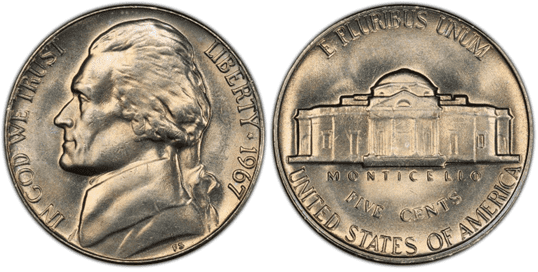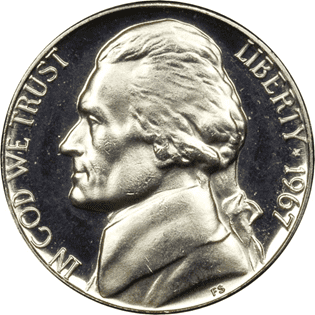What Is A 1967 Nickel Made Out Of?
In 1938, the Jefferson Nickel was introduced to replace the Buffalo Nickel, which had been in use since 1913.
The obverse side of the coin depicts an image of Thomas Jefferson, who was the 3rd president of the United States from 1801 to 1809, as well as the inscription ‘IN GOD WE TRUST.’
Both the obverse and reverse sides were designed and sculpted by Felix Schlag.
The back of the coin features a rendering of Monticello, President Thomas Jefferson’s Virginia residence, along with the letters ‘E PLURIBUS UNUM,’ (translation: out of many, one), ‘MONTICELLO,’ ‘FIVE CENTS,’ and ‘UNITED STATES OF AMERICA.’ The 1967 Jefferson nickel has a 5 cents face value and smooth edges.
The 1967 Nickel is made up of 75% copper and 25% nickel cladding, giving it a silver tone without any silver content found in the coin.
107,325,800 1967 Nickels were minted in Denver, San Francisco, and Philadelphia, but due to the move by congress to prevent coin collecting, feature no mint marks. (Mint Marks would resume in 1968).
However, unlike the last couple of years in this dark time of coin collecting special mint sets, (SMS), often deemed by coin collectors to be of lower quality than proof sets, which had become banned, were struck this year.
In 1967, the Vietnam War had already begun. The American Basketball Association is established, while Charlie Chaplin’s final film is released. The city of Chicago is hit by the worst blizzard it has ever seen.
The body of US President John F. Kennedy is relocated to a permanent burial location at Arlington National Cemetery.
1967 Nickel Varieties
1. 1967 Jefferson Nickel No Mint Mark (Regular Strike)
Year: 1967
Face Value: $0.5
Composition: 75% Copper, 25% Nickel
Total Weight: 5g
Diameter: 21.2 mm
Thickness: 1.75 mm
Edge: Plain
Minted in: Philadelphia/Denver/San Francisco
Quantity Minted: 107,325,800

photo source: www.pcgs.com
2. 1967 Jefferson Nickel No Mint Mark (Special Mint Set)
Year: 1967
Face Value: $0.5
Composition: 75% Copper, 25% Nickel
Total Weight: 5g
Diameter: 21.2 mm
Thickness: 1.75 mm
Edge: Plain
Minted in: San Francisco
Quantity Minted: 1,863,344

photo source:
3. 1967 Jefferson Nickel Full Steps

photo source:news.coinupdate.com
4. 1967 Jefferson Nickel Struck on a Dime Planchet

photo source:coins.ha.com
The most basic type of planchet error occurs when the wrong planchet is fed into the press. Only planchets of the correct or lesser size can be struck within the press since both the loading tube and the die collar are sized for the appropriate denomination of coin.
This means that quarter dollar dies can strike a dime planchet, but dime dies cannot strike a quarter dollar planchet because it will not fit into either the feeder tube or the collar. In the above example, the 1967 Nickel has been struck on a Dime planchet, leading to much of the design being clipped away.
Also known are 1967 5C coins struck on cent planchets.
How Much Is A 1967 Nickel Worth Today?
The melt value of the 1964 Nickel is roughly $0.0567 due to its lack of precious metal content, meaning that there is essentially no value in melting down this coin.
1967 Nickel Values
| Coin | G | VG | F | VF | XF | AU | Uncirculated |
| 1967 Nickel (Regular Strike) | – | $0.08 | $0.08 | $0.16 | $0.16 | $0.21 | $0.43 |
| 1967 Nickel (SMS) | – | – | – | – | – | – | $1.86 |
How Does The Grading System Work?
The Sheldon Scale is used by numismatists to provide a numerical value to coins. The Sheldon Scale goes from poor (P-1) to perfect mint state (P-1) (MS-70). Coins were originally evaluated using words to reflect their condition (Good, Fair, Excellent, Etc.). Unfortunately, coin collectors and dealers had different ideas about what each of these terms represent.
Professional numismatists joined together in the 1970s and established CoinGrading standards. These numismatists now assign grades at key places on the seventy-point scale, using the most regularly utilized numeric points in conjunction with the original adjective grade. The following are the most common coin grades:
-
-
- (P-1) Poor – Indistinguishable and probably damaged; if used, must have a date and mintmark; otherwise, rather battered.
- (FR-2) Fair – Nearly smooth, but without the damage that a coin graded Poor often possesses. The coin must have enough detail to be identified.
- (G-4) Fair – Inscriptions have merged into the rims in some areas, and important elements have been mostly erased.
- (VG-8) Very Good- A little weathered, but all of the primary design elements are visible, albeit faintly. There is little if any, central detail left.
- (F-12) Good – The item is very worn, yet the wear is even, and the overall design details stand out clearly. Rims are almost completely isolated from the field.
- (VF-20) Very Fine – Moderately weathered, with some finer features still visible. The motto or all letters of LIBERTY are readable. Both sides of the coin have entire rims that are separated from the field.
- (EF-40) Extremely Fine – Gently used; all gadgets are visible, and the most important ones are bold. The finer details are bold and clear, however, light wear may be seen.
- (AU-50) Uncirculated – Slight evidence of wear on the coin’s design’s high points; may have contact marks; eye appeal should be adequate.
- (AU-58) Uncirculated Choice – Slight traces of wear, no severe contact marks, almost full mint shine, and great eye appeal.
- (MS-60) Mint State Basal – Strictly uncirculated; no indication of wear on the coin’s highest points, but an unsightly coin with reduced luster, visible contact marks, hairlines, and other flaws.
- (MS-63) Mint State Acceptable – Uncirculated, but with contact scratches and nicks, little reduced shine, but otherwise appealing appearance. The strike is weak to average.
- (MS-65) Mint State Choice – Uncirculated with great mint shine, very little contact blemishes, and exceptional eye appeal. The strike is unusually severe.
- (MS-68) Mint State Premium Quality – Uncirculated with superb luster, no obvious contact marks to the naked eye, and exceptional eye appeal. The strike is quick and appealing.
- (MS-69) Almost Perfect Mint State – Uncirculated with perfect brilliance, a sharp and appealing strike, and extremely good eye appeal. A near-perfect coin with minor imperfections in the planchet, strike, and contact markings (seen only under 8x magnification).
- (MS-70) Mint State Perfect – Under 8x magnification, there are no tiny imperfections discernible; the strike is crisp, and the coin is perfectly centered on a beautiful planchet. Rarely seen on a coin, this coin is bright and whole, with original luster and exceptional eye appeal.
-
Where To Buy Or Sell 1967 Nickels?
Nickels from 1967 are available for purchase and sell in a number of ways. Because they’re still in circulation, you might find one or two in your pocket change.
Of course, eBay and Etsy are great places to look for basic, circulated coins. Check the coin for any minor flaws, such as 5 clear steps on the Monticello building, before selling it, as this might raise the value of your currency.
If you’re unsure, or if you think you have an exceptional coin, have it appraised by an expert, either in person or via an online professional.
FAQs
What is the value of a 1967 Canadian nickel?
In circulated condition, the 1967 Canadian Nickel which features a rabbit in its design has a value of $10-25c.
What year of nickels are worth keeping?
Jefferson Nickels, sometimes known as War Nickels, were issued between 1942 and 1945 and contained 35 per cent silver. This indicates they are worth more than face value and have been taken out of circulation for the most part.
What are the rarest 1967 nickels?
SMS 1967 Nickels, 1976 Nickels will full steps, and 1967 nickels which exhibit errors are the rarest types of this coin.




